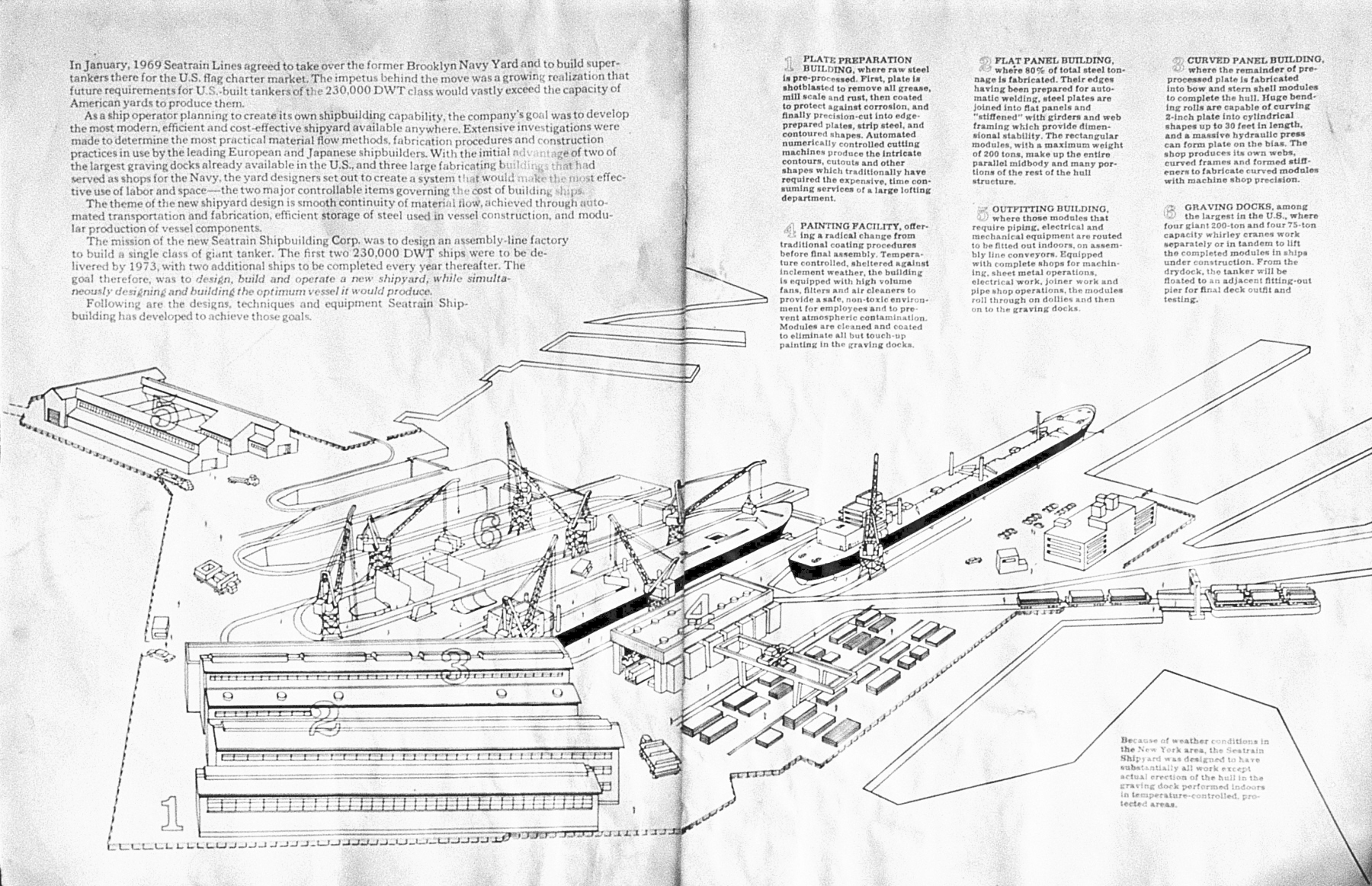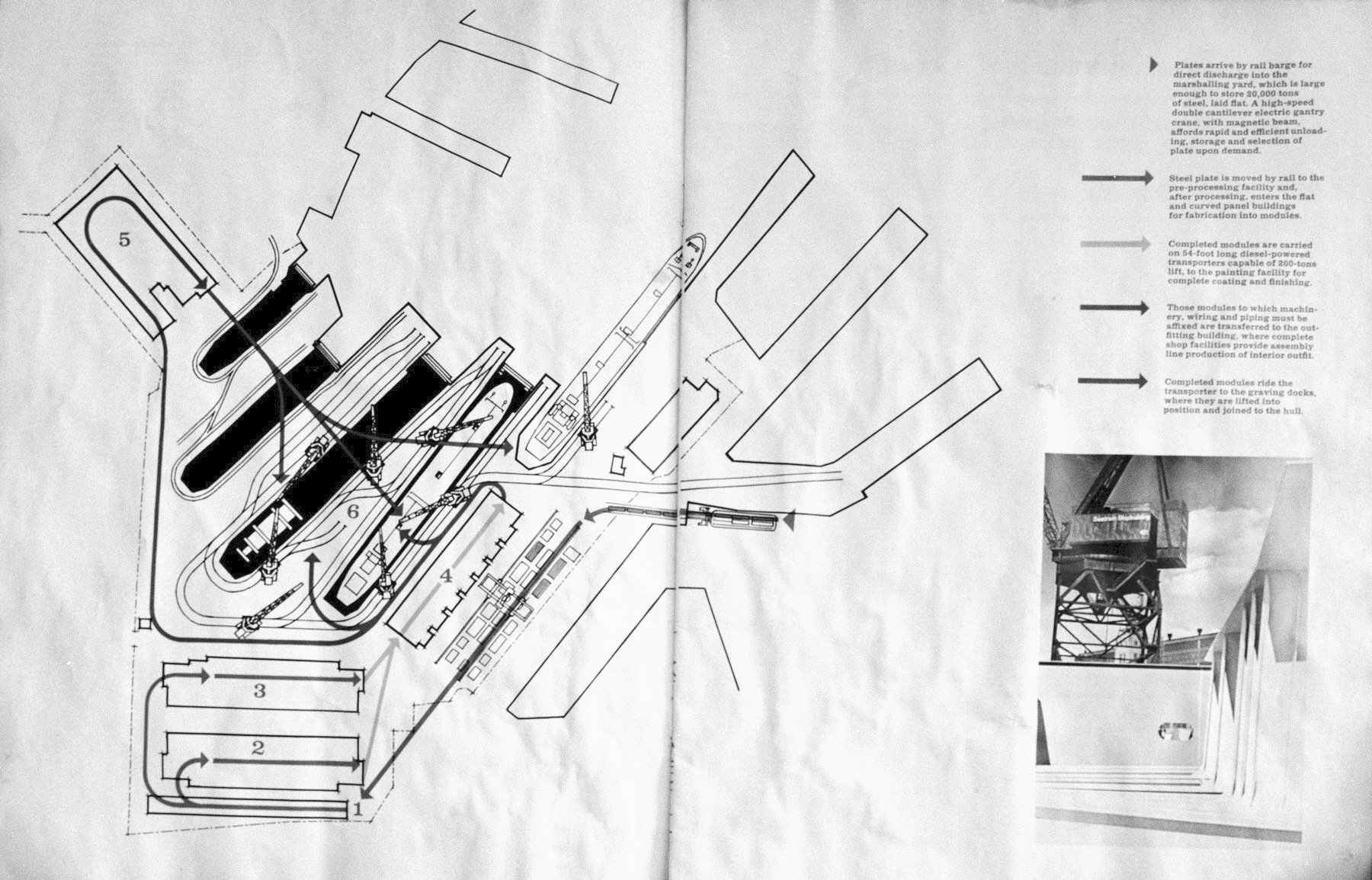INDUSTRIAL & TERMINAL RAILROADS &
RAIL-MARINE OPERATIONS
OF BROOKLYN, QUEENS, STATEN
ISLAND, BRONX &
MANHATTAN:
SEATRAIN
SHIPBUILDING & RAILWAY
Brooklyn Navy Yard, Brooklyn
.
.
.
.
updated: |
||
|
|
||
update summary: |
date: | |
| locomotive data & dispositions expanded & corrected | 3/30/2021 | |
.
.

History
.
Seatrain Shipbuilding was established by Seatrain Lines in 1968 as a wholly owned subsidiary, to lease the big docks and surrounding property of the recently civilianized New York Naval Shipyard, better known as the "Brooklyn Navy Yard".
Special thanks is due to Frank J. Trezza for the history and information on Seatrain Shipbuilding, which is available in his book and associated website: www.BrooklynSteel-BloodTenacity.com
Seatrain Shipbuilding was organized with the intent to build five 225,000 ton Very Large Crude Carriers (VLCC's) more commonly called "supertankers". Seatrain would build four 220,000 ton VLCC's, eight Barges, one Ice Breaker Barge and two Roll On - Roll Off's (Ro-Ro's). One Ro-Ro was never finished and was scrapped.
Seatrain Shipbuilding also had a contract to rebuild the burned out hull of the "Sea Witch", which was the freighter that collided with the "SS Esso Brussels" in New York Harbor on May 30, 1973; causing both vessels to catch fire and then while burning, drifted under the Verrazano Narrows Bridge!
Quick Sidenote:
If you lived in Brooklyn at this time, you might recall the
New York City
The underside of the Verrazano Narrows Bridge was scorched For more info on this collision / fire, I suggest: www.professionalmariner.com |
|
.
The Sea Witch was brought to Dry Dock #7 on the Brooklyn Navy Yard, were it was to be turned into a chemical tanker by Seatrain Shipbuilding. It sat in the Brooklyn Navy Yard for eight years, and this conversion was not to be.
According to websites of Wikimapia, and Resolve Marine Group, the Sea Witch was towed to Kurt Iron and Metal Co in Newport News, Virginia; where the hull was converted to an an open hulled receptacle for the storage of liquid waste contaminates resulting from the scrapping of other ships at this location.
Returning to the history of Seatrain Shipbuilding, which unfortunately was a dismal failure in almost every way and went bankrupt in February 1981. Exact causes are not known, but it must be considered that the economic crisis of New York City in the 1970's played a contributing factor in the failure of Seatrain Shipbuilding.
Inbound railcars of various freight, such as but not limited to: structural and sheet steel, anchor chain and other material required for the overhaul, retrofit and outright construction of marine vessels.
This inbound freight would have to be carfloated to the Brooklyn Navy Yard by the Brooklyn Eastern District Terminal, which held the carfloating contract for the Brooklyn Navy Yard since the early 1940's, right up through 1983, when Brooklyn Eastern District Terminal went out of business themselves.
John Bartelstone was kind enough to furnish the following images of a sales prospectus of Seatrain Shipbuilding, and shows the raw material receiving, fabrication and assembly procedure. Naturally, the receipt of raw material involves the locomotives and railroad of Seatrain, and interesting enough, the illustrations show carfloats, float bridge and basic routing of yard trackage.
 |
| .
. |
 |
.
Locomotives
.
Thanks to photographs taken by Tim Darnell and Tom Flagg, we know for fact that Seatrain Shipbuilding was known to employ the use of General Electric model 44 Ton locomotives during its tenure at the Brooklyn Navy Yard. It was originally believed that Seatrain owned only operated a single locomotive at this location.
Paul Strubeck went on to inform me that he was aware of two Seatrain Shipbuilding locomotives, both of which were General Electric 44 ton centercab models. In response to an email concerning this revelation, Tim confirms both of his images were taken same day, at different locations. With one locomotive clearly out of service, we can now definitively conclude that Seatrain had at least two locomotives located at the Brooklyn Navy Yard.
On 19 April, 2009, Jay Reed informs me that Seatrain purchased three General Electric 44 tonners from the Pennsylvania Railroad. Purchased were PRR #9318, #9319 and #9322; General Electric c/n's 31036, 30137 and 30140, respectively. All were built April 1949.
Frank Trezza, author of " Brooklyn Steel-Blood Tenacity", states:
"The locomotive you are looking at was used to move flat bed rail cars carrying flat plate steel. Barges were towed into the Brooklyn Navy Yard and the locomotive would move the rail cars over to the plate storage area roughly 200 yards from Dry Dock #6."
A problem arose in determining which two locomotives are seen in the Tim Darnell photos, in that the Seatrain locomotives were apparently transferred between Edgewater, NJ and San Juan, Puerto Rico; perhaps several times each, as maintenance required. So the problem is determining which locomotive is which. The only known information that Jay Reed ascertained is that the 44 ton that went to GE at Hornell, was reportedly c/n 31036 (ex-PRR #9318). He goes on to state wherever c/n 31036 went (most likely to scrap), it was gone by 1982.
In the Rail Marine Information Group publication "Transfer #43"; Tom Flagg took an aerial photograph dated 1972 (Figure #9, page 9) of the float bridge, gantry and surrounding area of the Brooklyn Navy Yard. Paul Strubeck already had larger electronic copy of this image in his collection, which he in turn, furnished to me. As I still found a need for an even higher resolution image, I contacted Tom Flagg for a rescan of the Navy Yard aerial image, which he was gracious enough to provide. Tom noted that the original furnished date of that image was incorrect, and that he took the photo in July 1977, not 1972 as published in the Transfer #43 and previously stated here.
Upon review of Tom Flagg's rescanned image TF 2a, Joe Roborecky and myself analyzed the image intensively. Both centercabs have a two stanchion handrail to each side of the cab. General Electric 44 ton locomotive models had this handrail arrangement, but the General Electric 80 ton model did not. Therefore, I have concluded that the locomotive in both of Tim Darnell's images are General Electric 44 ton models. However, if one examines the image closely, one unit is slightly different from the other. Joe pointed out the body lines of the locomotive closet to the crane has slightly more rounded and curved body lines, and the locomotive next to the ALCo, has sharper and more squared edges.
The other good news is, thanks to Tom's high resolution scans; we can now positively identify the ALCo locomotive as a Brooklyn Eastern District Terminal unit, and appears to be #23. This conclusion is based several individual body characteristics on the locomotive: hood stripe configuration and character width of the numbers on the cab. Also, the smokestack is brightly colored in the Tom Flagg image (and centered on the top of the hood!), and #23 had in fact a freshly repainted (in silver) smoke stack the year of this photo, while other BEDT locomotives did not. Also taken into consideration is the full size grill over the exhaust fan on the nose of the locomotive.
What could not be seen in the first set of aerial images, but clearly visible in images TF 3a and 3b; is that the General Electric 44 ton locomotive closest to the crane, is in process of being scrapped as one whole hood assembly in gone. I think we can now safely conclude the fate of that Seatrain 44 tonner. Unfortunately, we do not know the construction number or build date of this particular locomotive as yet.
As for the second Seatrain General Electric 44 tonner, which appears in service in images TD 2a and TD 2b, but is in the process of being serviced. It is in all likelihood that this is the locomotive seen in the Hornell, NY photos. Unfortunately, as with the Seatrain locomotive above, we do not the construction number or build date of this particular locomotive.
After viewing the Brooklyn Navy Yard in current aerial photos, I was able to identify and locate both structures behind the General Electric 44 ton locomotives in the Tim Darnell photos. See my notes below each image for location.
This Seatrain locomotive was later seen in a decrepit state in Hornell, NY in 1980 (very last Tim Darnell photo).
Special thanks to Charles Woolever, who forwarded the following disposition and history information on the Hornell Facility and the locomotives there on 27 August 2009:
"General Electric c/n 31036 did go to GE Hornell and was rebuilt as GE Hornell Apparatus Shop #442. It was not used a parts source for #442 and it lasted through to GE closing. When GE closed, no one seems to know where it went. Although it could have been scrapped, I witnessed the scrap train leave on Conrail and take the engines that were scrapped (mostly large GE U-boats) to a local Hornell scrapper. The switcher was not in that group. It could have been left for M-K when they took over but I never saw M-K use it. I lived right next to the shops.
GE also used a small 25 ton switcher #251. My guess is it shipped out on a flatcar or semi truck. No one knows where #251 went either. Also on your roster, GE c/n 30137 is ex-PRR 9319. You have 9318.
Your "history" on the GE shop is a bit backwards. (Which has now been removed - author)
When Conrail got the former Erie Lackwanna shops in 1976, they didn't need it. The local IDA took over finding someone to fill them. GE was the first customer and was there from the late 1970's to early 1980's (83-ish). Then Morrison - Knudson took over. While GE was mostly locomotive rebuilds and some passenger cars (and a small bit of paint work), Morrison - Knudson mostly did subway and commuter cars. Alstom took over from Morrison - Knudson and is still there."
|
| .
. |
|
| .
. |
|
| .
. |
|
| .
. |
|
| .
. |
|
| .
. |
|
| .
. |
|
| .
. |
|
| .
. |
image forthcoming September 4, 1979 - Hornell, NY note number 232 on nose M. Tedesco photo added 30 March 2021 |
| .
. |
|
| .
. |
|
.
.
Seatrain (Brooklyn Navy Yard) Roster
| number / name |
builder |
c/n |
build date |
gauge |
wheel arrangement |
model | acquired |
disposition |
notes |
ref |
| GE | 30136 | 4/13/1949 | std. | B-B | 44 Ton B-B-88/88-4GE733 |
used ex-PRR #9318 |
|
|
||
| GE | 30137 | 4/15/1949 | std. | B-B | 44 Ton B-B-88/88-4GE733 |
used ex-PRR #9319 |
unknown 1 |
|
||
| GE | 30140 | std. | B-B | 44 Ton B-B-88/88-4GE733 |
used ex-PRR #9322 |
to GE Hornell Apparatus Shop #442, Hornell, NY; appears to have been scrapped post 1980 |
|
Locomotive Footnotes
| 1 | Locomotives were apparently transferred between Edgewater, NJ
and San Juan, Puerto Rico, as maintenance required. Either of the two locomotives could be the one shown being scrapped for parts for the remaining loco at the Brooklyn Navy Yard in 1977, with the other locomotive being at either Edgewater or San Juan. |
Like what you see? Suggestions?
Comments?